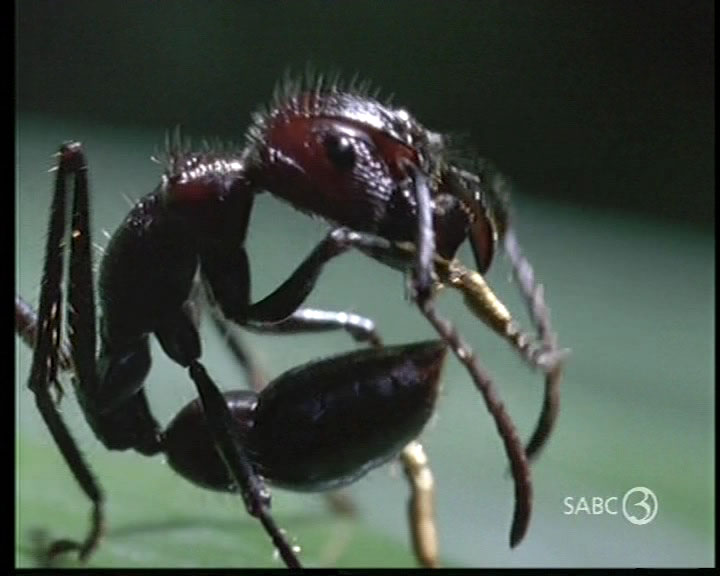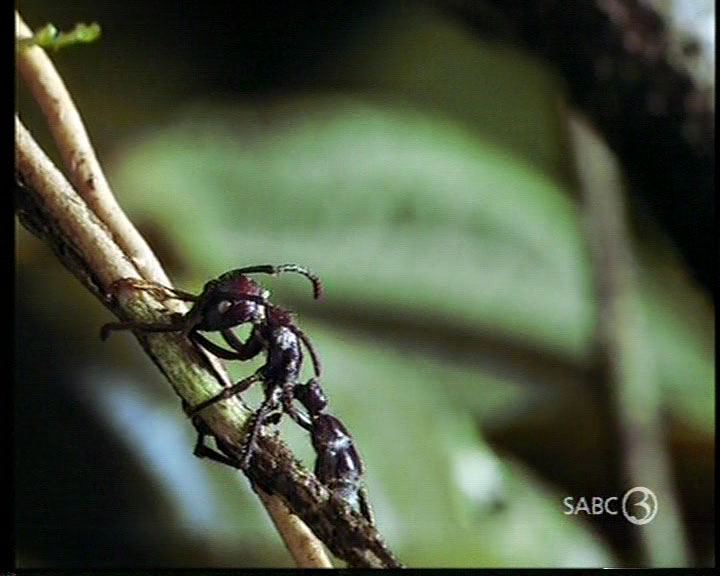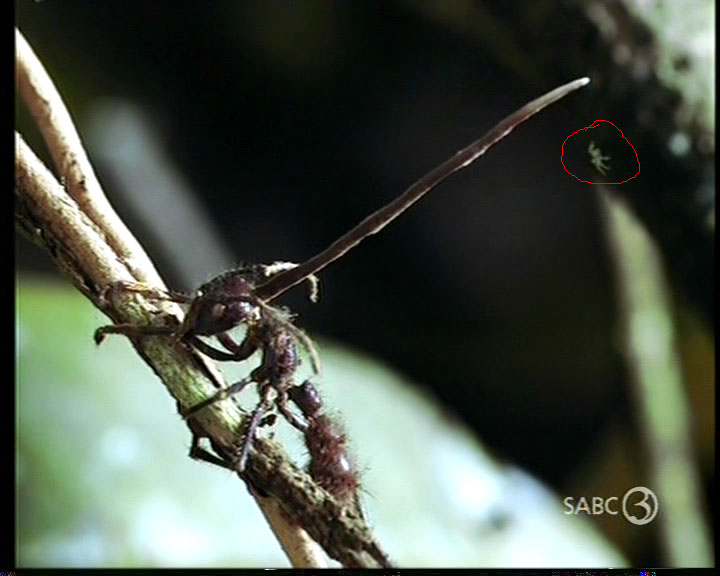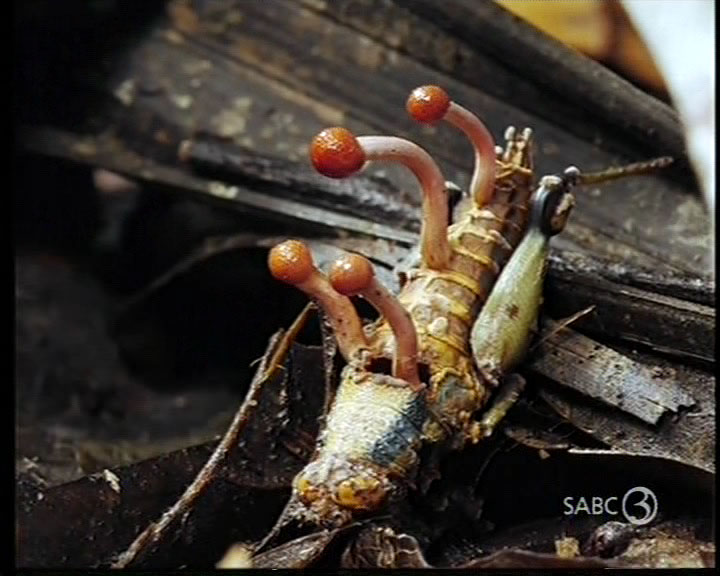 Author
Author
|
Topic: Cordyceps fungus infection controls ant brain (Read 17870 times) |
|
Blunderov
Archon
    
Gender: 
Posts: 3160
Reputation: 8.06
Rate Blunderov

"We think in generalities, we live in details"
  
|
 |
Cordyceps fungus infection controls ant brain
« on: 2007-01-24 13:56:47 » |
 |
[Blunderov] This from the BBC's Planet Earth. Very disturbing. Real live aliens in the backyard - could it happen to humans perhaps via biowarfare?
<snip>These Bullet ants are showing some worrying symptoms.Spores from a parasitic fungus called Cordyceps have infiltrated their bodies and their minds. Its infected brain directs this ant upwards then, utterly disorientated, it grips a stem with its mandibles.

Those afflicted that are discovered by the workers are quickly taken away and dumped far away from the colony. It seems extreme but this is the reason why. Like something out of science fiction the fruiting body of the Cordyceps erupts from the ant’s head.

It can take three weeks to grow and when finished the deadly spores will burst from it’s tip then any ant in the vicinity will be in (sic) serious risk of death.

The fungus is so virulent it can wipe out whole colonies of ants and it’s not just ants that fall victim to this killer. There are literally thousands of different types of Cordyceps fungi and remarkably each specializes on (sic) just one species.

|
|
|
|
|
Walter Watts
Adept
    
Gender: 
Posts: 1571
Reputation: 7.99
Rate Walter Watts

Just when I thought I was out-they pull me back in
  
|
 |
Re:Cordyceps fungus infection controls ant brain
« Reply #1 on: 2007-01-24 16:45:09 » |
 |
Wouldn't this level of hostility toward your host eventually become an evolutionary dead-end for Cordyceps?
Walter
"All your ants are belong to us"
---Conrad P. Cordyceps
|
Walter Watts
Tulsa Network Solutions, Inc.
No one gets to see the Wizard! Not nobody! Not no how!
|
|
|
Blunderov
Archon
    
Gender: 
Posts: 3160
Reputation: 8.06
Rate Blunderov

"We think in generalities, we live in details"
  
|
 |
Re:Cordyceps fungus infection controls ant brain
« Reply #2 on: 2007-01-25 01:07:53 » |
 |
Quote from: Walter Watts on 2007-01-24 16:45:09
Wouldn't this level of hostility toward your host eventually become an evolutionary dead-end for Cordyceps?
Walter
"All your ants are belong to us"
---Conrad P. Cordyceps
|
[Blunderov] I have an idea that spores last virtually indefinitely. So, the Cordyceps just waits. It has time. Unlike we humans who appear to be destroying our host without having the option of lurking in the background until something else tasty wanders by.
Best regards.
|
|
|
|
|
Blunderov
Archon
    
Gender: 
Posts: 3160
Reputation: 8.06
Rate Blunderov

"We think in generalities, we live in details"
  
|
 |
Re:Cordyceps fungus infection controls ant brain
« Reply #3 on: 2007-01-25 04:21:31 » |
 |
[Blunderov] I've been wondering why it is that I find the Cordyceps so very disturbing. I think it must be that the fungus seems to exist on the borderline of both biology and information; literally and figuratively a mind-blowing niche.
How are we to tell whether we use information or whether information uses us? Shades of The Matrix. Woo.
|
|
|
|
|
Blunderov
Archon
    
Gender: 
Posts: 3160
Reputation: 8.06
Rate Blunderov

"We think in generalities, we live in details"
  
|
 |
Re:Cordyceps fungus infection controls ant brain
« Reply #4 on: 2007-01-26 16:48:32 » |
 |
[Blunderov] It turns out that NeuroPhilosopher noticed the same sequence in "The Planet Earth" a little while before I did and posted a much more informative article on the subject at
Brainwashed by a parasite
Brainwashed by a parasite
Posted by MC on November 20th, 2006
The carpenter ant in the picture on the left (genus Campanotus), and the bullet ant in the first film clip below (Paraponera clavata), have fallen victim to parasitic fungi of the genus Cordyceps, which manipulate the behaviour of their host in order to increase their own chances of reproducing.
The spores of the fungus attach themselves to the external surface of the ant, where they germinate. They then enter the ant’s body through the tracheae (the tubes through which insects breathe), via holes in the exoskeleton called spiracles. Fine fungal filaments called mycelia then start to grow inside the ant’s body cavity, absorbing the host’s soft tissues but avoiding its vital organs.
When the fungus is ready to sporulate, the mycelia grow into the ant’s brain. The fungus then produces chemicals which act on the host’s brain and alter its perception of pheromones. This causes the ant to climb a plant and, upon reaching the top, to clamp its mandibles around a leaf or leaf stem, thus securing it firmly to what will be its final resting place.
The fungus then devours the ant’s brain, killing the host. The fruiting bodies of the fungus sprout from the ant’s head, through gaps in the joints of the exoskeleton. Once mature, the fruiting bodies burst, releasing clusters of capsules into the air. These in turn explode on their descent, spreading airborne spores over the surrounding area. These spores then infect other ants, completing the life cycle of the fungus. Depending on the type of fungus and the number of infecting spores, death of an infected insect takes between 4-10 days.
The ant in the photograph on the left has been infected by Cordyceps unilateralis, which is but one of thousands of species of entomopathogenic fungi, more than 400 of which belong to the Cordyceps genus. Between them, these parasitic fungi infect at least nine different orders of arthropods, including the Odonata (dragonflies and damselflies), Blattaria (cockroaches), Hemiptera (aphids, cicadas and leafhoppers), Coleoptera (beetles), Phasmida (stick insects), Hymenoptera (ants, bees and wasps), and Lepidoptera (butterflies and moths). The host range of an individual species is, however, restricted to one species or to a small number of closely related species.
Because they are considered as environmentally safe, natural mortality agents, entomopathogenic fungi are used as biological pesticides to control pest species. For example, Metarhizium anisopliae was first used over 100 years ago to try and control the wheat grain beetle Anisoplia austriaca. More recently, researchers have investigated the use of Metarhizium anisopliae, a species which infects the African mosquito Anopheles gambiae, to control the spread of malaria.
Entomopathogenic fungi are not the only parasites that can modify the behaviour of their hosts. Equally remarkable is the nematomorph hairworm Spinochordodes tellinii, which is also known as the horsehair worm or the gordian worm, because of its resemblance to the knot created by the Phrygian king Gorius. (According to myth, Gordius used his knot to tie a chariot to a pole, and declared that whoever could untie it would rule all of Asia.)
The juvenile gordian worm parasitizes land-living arthropods such as grasshopers, locusts and beetles, but the adult is a free-living aquatic species which can only reproduce in water. Inside the host, the microscopic larvae feed on surrounding tissue, and develop into long worms which can reach up to 4 times the length of the host, and which remain within the body cavity of the host as a long, coiled mass. After metamorphosing, the adult worm induces its host to leave its terrestrial habitat, and to commit suicide by jumping into water and drowning itself, so that the worm can emerge:
David Biron and his colleagues have used proteomics to characterise the proteins synthesized by the gordian worm in order to determine how it manipulates its host’s behaviour. They have established that the worm synthesizes proteins which mimic those produced by the insect. These include proteins of the Wnt family, which are involved in the development of the nervous system, as well as others which interfere with the neurotransmitter systems involved in the host’s geotactic behaviour (its oriented movements in relation to the Earth’s magnetic field).
Because the genes encoding these proteins are contained in the worm’s genome, but have a direct effect on the insect’s central nervous system when they are expressed, the relationship between the gordian worm and its host is an example of what Richard Dawkins called the extended phenotype, whereby genes expressed by one organism have an effect on the appearance or behaviour of another. (Entomopathogenic fungi and their hosts are also an example of an extended phenotype.)
Incredibly, the gordian worm can survive predation on its host. Parasites use various strategies to survive host predation. For example, some develop quickly, in order to emerge from the host before it is preyed upon. Grasshoppers and crickets are preyed upon by fish and frogs; the gordian worm can escape this predation by wriggling out of the mouth, nose or gills of the predator once it has emerged from a host that has been eaten:
Links:
Biron, D. G., et al (2005). Behavioural manipulation in a grasshopper harboring hairworm: a proteomics approach. Proc. R. Soc. B. 272: 2117-2126.
Thomas, F., et al (2003). Biochemical and histological changes in the brain of the cricket Nemobius sylvestris infected by the manipulative parasite Paragordius tricuspidatus (Nematomorpha). Int. J. Parasitol. 33: 435-443.
Related posts:
Insect strategies for avoiding parasitic infections
[Edit]
18 Responses to “Brainwashed by a parasite”
Alex Says:
November 21st, 2006 at 4:32 pm
Human beings have something similar to the first example. It enters through the ears at an early age, germinates in the mind, and causes the host to destroy rival communities, whilst reproducing abnormally rapidly, thus permitting the parasite to breed, exit via the mouth, and infect others. It is commonly known as..
pinguicula Says:
November 28th, 2006 at 6:21 pm
Cordyceps fungi were recently featured in the BBC’s Planet Earth series, including a truly creepy time-lapse sequence of a fruiting body erupting from an ant’s head.
The neurophilosopher Says:
November 28th, 2006 at 6:30 pm
I saw that program - it was what inspired me to research and write about this extraordinary phenomenon! I’ve found the Attenborough clip on YouTube, and added it to the post.
Simon1607 Says:
November 29th, 2006 at 2:36 pm
I too saw the programme and it has given me some fantastic ideas for stories…perhaps verging a bit too close to X-Files…nonetheless the image of the ant in time-lapse death sequence was truly a great example of how creepy and “alien” nature can be.
Imagine a human version! Eeeeeep!
Bill Says:
December 3rd, 2006 at 3:38 am
That is got to be some of the messed up creatures I have ever seen. A+++
meneame.net Says:
December 3rd, 2006 at 10:02 pm
Más sobre parásitos que controlan el cerebro de su huésped
Impresionante entrada (con video incluido) de un hongo que parasita el cerebro de diferentes insectos y manipula su comportamiento hasta causarles la muerte. En el mismo post se repasan otros clásicos como el gusano que hace que un grillo se suicide (…
Iterativa Says:
December 4th, 2006 at 4:34 am
[…] Interesante video. En la explicación para este comportamiento, lo definen como una especie de “control mental”, aunque dudo que sea tal cual (es decir, nada como en la sci-fi). […]
El bonsai Geek Says:
December 4th, 2006 at 9:48 pm
[…] La vida natural es una lucha por la supervivencia y la estrategia más adecuada para que la especie se multiplique. Existen miles de estrategias; curiosa la de una familia de hongos capaces de manipular el comportamiento de su huesped. […]
fukunori Says:
December 6th, 2006 at 12:48 pm
phenomenal insights of the small worlds…
for more mindcontrol parasites (this time: snails) check this mindblowing film out:
http://www.youtube.com/watch?v=EWB_COSUXMw
have a nice mindcontrolled day;) fu
Words Says:
December 7th, 2006 at 11:40 am
Circus of the Spineless #15
Welcome to the 15th edition of Circus of the Spineless. Appropriately enough, we have 15 contributors offering a diverse selection of posts about invertebrate fauna. The Red Eyes by Samuel Yung As ever, insects are the most popular subjects. Photographer
kimito Says:
December 9th, 2006 at 10:51 am
This idea was used 10 years ago by a Japanese author for a comic book. A villian had the power to infect anyone who fell onto lower ground than him with spores and fungus. Jojo’s Bizarre Adventure Stand Name: Green Day.
Libersat Says:
December 10th, 2006 at 11:13 am
Hi,
I am writing a review on host manipulation by parasites. Where can I find information (a scientific article) regarding the following quote in the blog “The fungus then produces chemicals which act on the host’s brain and alter its perception of pheromones. This causes the ant to climb a plant and, upon reaching the top, to clamp its mandibles around a leaf or leaf stem, thus securing it firmly to what will be its final resting place”
Thank you for your kind help,
Fred
The neurophilosopher Says:
December 12th, 2006 at 10:26 am
Libersat, I found that information on a website when I googleed “Cordyceps”. I can’t remember the site unfirtunately, but the papers I’ve linked to in the post contain information about how the chemicals produced by the horsehair worm affect the brain of of the host. I hope this is of help to you.
Matthew Sanders Says:
December 14th, 2006 at 9:11 pm
[…] If that doesn’t disturb you. Read the full story here […]
fununtilyourfriendsfindout Says:
December 15th, 2006 at 6:42 am
[…] Found at: The Neurophilosopher’s weblog […]
Pet Lover Says:
January 1st, 2007 at 4:57 am
Hey there was surfing through the internet and found your page on google . Enjoyed the good read wanted to say Happy New Year and keep up the good work.
Wendee Holtcamp Says:
January 9th, 2007 at 6:04 am
Can you tell me your reference for this info: “The fungus then produces chemicals which act on the host’s brain and alter its perception of pheromones”
I’m working on a project (I’m a freelance writer) about this and finding someone who works on bullet ants OR Cordyeps as been impossible… I need to verify that info that you’ve posted. Thanks!
MC Says:
January 9th, 2007 at 8:24 am
Wendee, please read the reply to Libersat’s comment above. I had the same difficulty finding scientific information about this fascinating topic. Click on the pics and you’ll be redirected to the websites of labs doing research into manipulative parasites.
|
|
|
|
|
|




